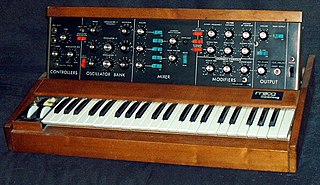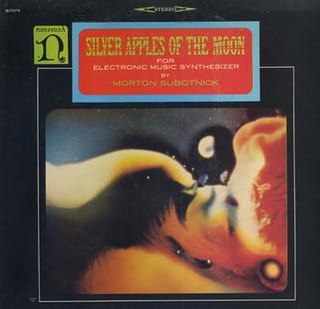Related Research Articles
Electronic music broadly is a group of music genres that employ electronic musical instruments, circuitry-based music technology and software, or general-purpose electronics in its creation. It includes both music made using electronic and electromechanical means. Pure electronic instruments depended entirely on circuitry-based sound generation, for instance using devices such as an electronic oscillator, theremin, or synthesizer. Electromechanical instruments can have mechanical parts such as strings, hammers, and electric elements including magnetic pickups, power amplifiers and loudspeakers. Such electromechanical devices include the telharmonium, Hammond organ, electric piano and electric guitar.

Robert Arthur Moog was an American engineer and electronic music pioneer. He was the founder of the synthesizer manufacturer Moog Music and the inventor of the first commercial synthesizer, the Moog synthesizer, which debuted in 1964. In 1970, Moog released a more portable model, the Minimoog, described as the most famous and influential synthesizer in history. Among Moog's honors are a Technical Grammy Award, received in 2002, and an induction into the National Inventors Hall of Fame.

The theremin is an electronic musical instrument controlled without physical contact by the performer. It is named after its inventor, Leon Theremin, who patented the device in 1928.
Wendy Carlos is an American musician and composer best known for electronic music and film scores.

The Minimoog is an analog synthesizer first manufactured by Moog Music between 1970 and 1981. Designed as a more affordable, portable version of the modular Moog synthesizer, it was the first synthesizer sold in retail stores. It was first popular with progressive rock and jazz musicians and found wide use in disco, pop, rock and electronic music.

Switched-On Bach is the debut album by the American composer Wendy Carlos, released in October 1968 by Columbia Records. Produced by Carlos and Rachel Elkind, the album is a collection of pieces by Johann Sebastian Bach performed by Carlos and Benjamin Folkman on a Moog synthesizer. It played a key role in bringing synthesizers to popular music, which had until then been mostly used in experimental music.
Paul Henry Beaver Jr. was an American musician who was a pioneer in popular electronic music, using the Moog synthesizer. From 1967, Beaver collaborated with Bernie Krause as the recording duo Beaver & Krause.

The clavioline is an electronic analog synthesizer. It was invented by French engineer Constant Martin in 1947 in Versailles.

Electronic Sound is the second studio album by the English rock musician George Harrison. Released in May 1969, it was the last of two LPs issued on the Beatles' short-lived Zapple record label, a subsidiary of Apple Records that specialised in the avant-garde. The album is an experimental work comprising two lengthy pieces performed on a Moog 3-series synthesizer. It was one of the first electronic music albums by a rock musician, made at a time when the Moog was usually played by dedicated exponents of the technology. Harrison subsequently introduced the Moog to the Beatles' sound, and the band featured synthesizer for the first time on their 1969 album Abbey Road.

The Moog synthesizer is a modular synthesizer invented by the American engineer Robert Moog in 1964. Moog's company, R. A. Moog Co., produced numerous models from 1965 to 1981, and again from 2014. It was the first commercial synthesizer and established the analog synthesizer concept.

Bernard L. Krause is an American musician and soundscape ecologist. In 1968, he founded Wild Sanctuary, an organization dedicated to the recording and archiving of natural soundscapes. Krause is an author, a bio-acoustician, a speaker, and natural sound artist who coined the terms geophony, biophony, and anthropophony.
Peter Zinovieff was a British composer, musician and inventor. In the late 1960s, his company, Electronic Music Studios (EMS), made the VCS3, a synthesizer used by many early progressive rock bands such as Pink Floyd and White Noise, and Krautrock groups as well as more pop-orientated artists, including Todd Rundgren and David Bowie. In later life, he worked primarily as a composer of electronic music.

A synthesizer is an electronic musical instrument that generates audio signals. Synthesizers typically create sounds by generating waveforms through methods including subtractive synthesis, additive synthesis and frequency modulation synthesis. These sounds may be altered by components such as filters, which cut or boost frequencies; envelopes, which control articulation, or how notes begin and end; and low-frequency oscillators, which modulate parameters such as pitch, volume, or filter characteristics affecting timbre. Synthesizers are typically played with keyboards or controlled by sequencers, software or other instruments, and may be synchronized to other equipment via MIDI.
Biomusic is a form of experimental music which deals with sounds created or performed by non-humans. The definition is also sometimes extended to include sounds made by humans in a directly biological way. For instance, music that is created by the brain waves of the composer can also be called biomusic as can music created by the human body without the use of tools or instruments that are not part of the body.

Silver Apples of the Moon is the debut album by American composer and musician Morton Subotnick, released by Nonesuch Records in July 1967. It contains the titular composition which is divided into two parts. A showcase for the Buchla 100 synthesizer, an early analogue synthesizer that the composer helped develop, it was the first piece of electronic music commissioned by a record company.

The use of electronic music technology in rock music coincided with the practical availability of electronic musical instruments and the genre's emergence as a distinct style. Rock music has been highly dependent on technological developments, particularly the invention and refinement of the synthesizer, the development of the MIDI digital format and computer technology.

The Zodiac: Cosmic Sounds is a 1967 collaborative concept album on the theme of the signs of the Zodiac. It was issued by Elektra Records in and featured early use of the Moog synthesizer by Paul Beaver, with music written by Mort Garson, words by Jacques Wilson, and narration by Cyrus Faryar. Instrumentation was provided by members of the Wrecking Crew studio collective. It has been variously described as "a wonderful period piece" and "apt to inspire more giggle fits than stoned, pull-the-shades-down reveries".
In sound and music, an envelope describes how a sound changes over time. For example, a piano key, when struck and held, creates a near-immediate initial sound which gradually decreases in volume to zero. An envelope may relate to elements such as amplitude (volume), frequency or pitch.

Switched-On Rock is an album by the Moog Machine, released in 1969 on Columbia Records. It comprises instrumental covers of popular songs from the 1960s, performed on the Moog synthesizer. It was one of a spate of albums capitalizing on the success of Switched-On Bach (1968), an album of Bach pieces performed on the Moog by Wendy Carlos.
Electronic rock is a music genre that involves a combination of rock music and electronic music, featuring instruments typically found within both genres. It originates from the late 1960s when rock bands began incorporating electronic instrumentation into their music. Electronic rock acts usually fuse elements from other music styles, including punk rock, industrial rock, hip hop, techno and synth-pop, which has helped spur subgenres such as indietronica, dance-punk and electroclash.
References
- ↑ Unterberger, Richie. "Liner Notes for Beaver & Krause's "The Nonesuch Guide to Electronic Music"" . Retrieved July 1, 2023.
- ↑ Pinch & Trocco 2002, pp. 110–11.
- 1 2 Prendergast 2003, p. 307.
- ↑ Brend 2012, p. 151.
- ↑ Holmes 2012, p. 446.
- ↑ Pinch & Trocco 2002, pp. 118, 315.
- 1 2 Brend 2012, p. 166.
- 1 2 3 Cope, Julian ("the Seth Man") (June 2010). "Unsung: Beaver & Krauserocksampler". Head Heritage . Retrieved August 5, 2018.
- ↑ Billboard New York correspondent (May 26, 1973). "Beaver, Krause to Score Film". Billboard . p. 18. Retrieved August 9, 2018.
{{cite magazine}}:|author=has generic name (help) - ↑ Pinch & Trocco 2002, p. 127.
- ↑ Sandler, Ellen (1970). "Earth People's Pop". Saturday Review . Vol. 53. p. 113. Retrieved August 9, 2018.
- 1 2 Ankeny, Jason. "Beaver & Krause". AllMusic . Retrieved August 8, 2018.
- ↑ Prendergast 2003, p. 306.
- ↑ Pinch & Trocco 2002, p. 128.
- ↑ Unterberger, Richie (2010). "Liner Notes for Beaver & Krause's In a Wild Sanctuary (Collectors' Choice Music)". richieunterberger.com . Retrieved August 7, 2018.